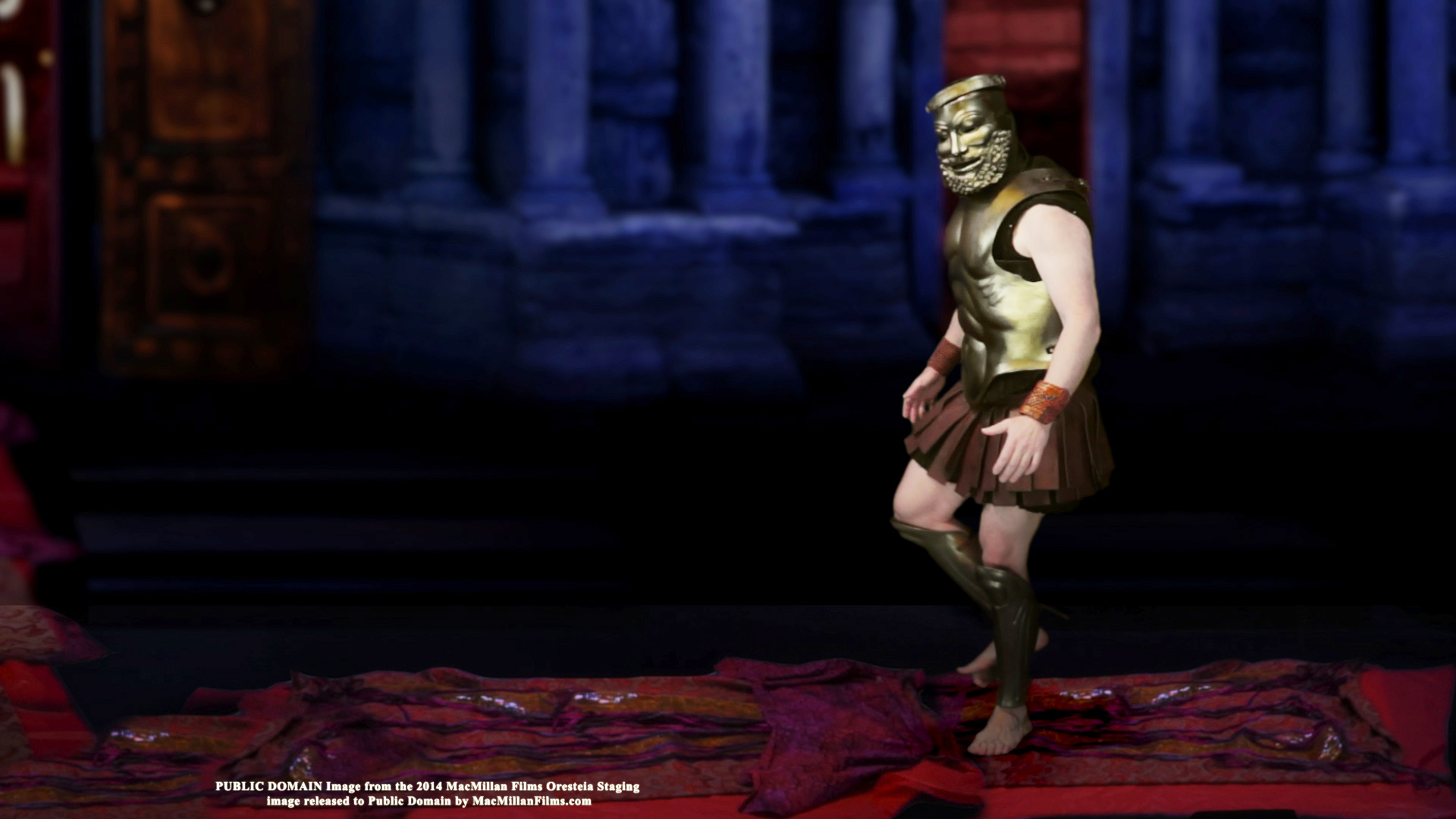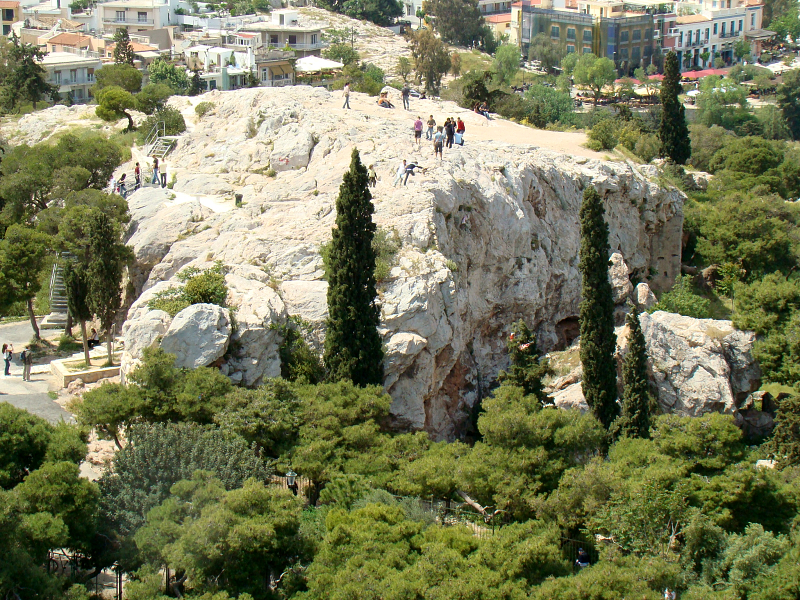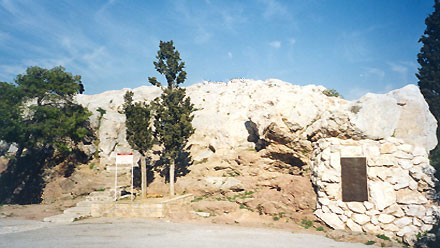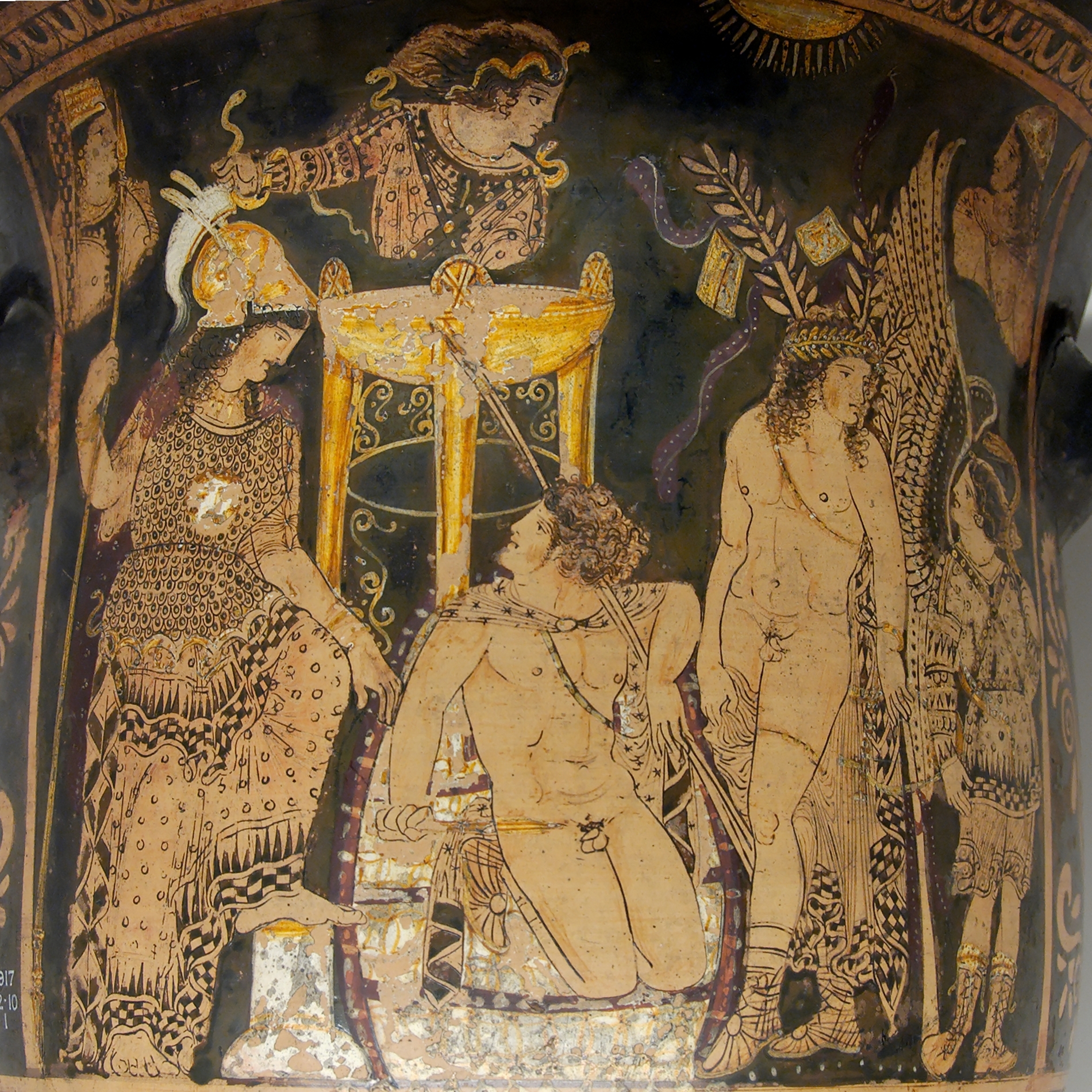|
Athena Areia
Areia ( grc, Ἀρεία) was a cultic epithet of the Greek goddess Athena, under which she was worshipped at Athens. Athena's statue, together with those of Ares, Aphrodite Areia, and Enyo, stood in the temple of Ares at Athens. There was also a colossal acrolithic statue of her, at a temple at Plataea, built with the spoils given to that city by the Athenians after the Battle of Marathon. This was supposedly created by the artist Pheidias, though there is some disagreement among modern scholars whether this was indeed created by that artist. Plutarch mentions a gilded statue in this temple, but does not specify the name of the deity it honors. Athena's worship under this name was said to have been instituted by Orestes after he had been acquitted by the Areopagus of the murder of his mother. It was Athena Areia who gave her casting vote in cases where the Areopagites were equally divided. There is some epigraphic evidence of a distinct priesthood for this aspect of Athena, b ... [...More Info...] [...Related Items...] OR: [Wikipedia] [Google] [Baidu] |
Greek Mythology
A major branch of classical mythology, Greek mythology is the body of myths originally told by the ancient Greeks, and a genre of Ancient Greek folklore. These stories concern the origin and nature of the world, the lives and activities of deities, heroes, and mythological creatures, and the origins and significance of the ancient Greeks' own cult and ritual practices. Modern scholars study the myths to shed light on the religious and political institutions of ancient Greece, and to better understand the nature of myth-making itself. The Greek myths were initially propagated in an oral-poetic tradition most likely by Minoan and Mycenaean singers starting in the 18th century BC; eventually the myths of the heroes of the Trojan War and its aftermath became part of the oral tradition of Homer's epic poems, the '' Iliad'' and the '' Odyssey''. Two poems by Homer's near contemporary Hesiod, the ''Theogony'' and the '' Works and Days'', contain accounts of the ... [...More Info...] [...Related Items...] OR: [Wikipedia] [Google] [Baidu] |
Oxford University Press
Oxford University Press (OUP) is the university press of the University of Oxford. It is the largest university press in the world, and its printing history dates back to the 1480s. Having been officially granted the legal right to print books by decree in 1586, it is the second oldest university press after Cambridge University Press. It is a department of the University of Oxford and is governed by a group of 15 academics known as the Delegates of the Press, who are appointed by the vice-chancellor of the University of Oxford. The Delegates of the Press are led by the Secretary to the Delegates, who serves as OUP's chief executive and as its major representative on other university bodies. Oxford University Press has had a similar governance structure since the 17th century. The press is located on Walton Street, Oxford, opposite Somerville College, in the inner suburb of Jericho. For the last 500 years, OUP has primarily focused on the publication of pedagogical texts an ... [...More Info...] [...Related Items...] OR: [Wikipedia] [Google] [Baidu] |
Acharnae
Acharnae or Acharnai (; grc, Ἀχαρναί) was a ''deme'' of ancient Athens. It was part of the phyle Oineis. Acharnae, according to Thucydides, was the largest deme in Attica. In the fourth century BCE, 22 of the 500 members of the boule (ancient Greece), Athenian council came from Acharnae, more than from any other deme. Name The place-name of Acharnae is most likely pre-Greek in origin, similar to other place-names throughout Attica. During antiquity it was believed that the name originated from the word () or (), meaning seabass, due to the shape of the plain that Acharnae was in looking like a fish. Another view was that the name originated from Acharnas, one of the mythical heroes from Attica and the supposed founder of the city. Location Acharnae was located in the west-northwest part of the Attic plain, 60 stadion (unit), stadia north of Athens, south of Mount Parnes. The site of Acharnae is located at and southwest of Menidi (renamed to modern Acharnes). It w ... [...More Info...] [...Related Items...] OR: [Wikipedia] [Google] [Baidu] |
Oresteia
The ''Oresteia'' ( grc, Ὀρέστεια) is a trilogy of Greek tragedies written by Aeschylus in the 5th century BCE, concerning the murder of Agamemnon by Clytemnestra, the murder of Clytemnestra by Orestes, the trial of Orestes, the end of the curse on the House of Atreus and the pacification of the Erinyes. The trilogy—consisting of '' Agamemnon'' (), ''The Libation Bearers'' (), and '' The Eumenides'' ()—also shows how the Greek gods interacted with the characters and influenced their decisions pertaining to events and disputes. The only extant example of an ancient Greek theatre trilogy, the ''Oresteia'' won first prize at the Dionysia festival in 458 BCE. The principal themes of the trilogy include the contrast between revenge and justice, as well as the transition from personal vendetta to organized litigation. ''Oresteia'' originally included a satyr play, ''Proteus'' (), following the tragic trilogy, but all except a single line of ''Proteus'' has been lost. ... [...More Info...] [...Related Items...] OR: [Wikipedia] [Google] [Baidu] |
Aeschylus
Aeschylus (, ; grc-gre, Αἰσχύλος ; c. 525/524 – c. 456/455 BC) was an ancient Greek tragedian, and is often described as the father of tragedy. Academic knowledge of the genre begins with his work, and understanding of earlier Greek tragedy is largely based on inferences made from reading his surviving plays. According to Aristotle, he expanded the number of characters in the theatre and allowed conflict among them. Formerly, characters interacted only with the chorus.The remnant of a commemorative inscription, dated to the 3rd century BC, lists four, possibly eight, dramatic poets (probably including Choerilus, Phrynichus, and Pratinas) who had won tragic victories at the Dionysia before Aeschylus had. Thespis was traditionally regarded the inventor of tragedy. According to another tradition, tragedy was established in Athens in the late 530s BC, but that may simply reflect an absence of records. Major innovations in dramatic form, credited to Aeschylus by Aristotle ... [...More Info...] [...Related Items...] OR: [Wikipedia] [Google] [Baidu] |
Areopagites
The Areopagus () is a prominent rock outcropping located northwest of the Acropolis in Athens, Greece. Its English name is the Late Latin composite form of the Greek name Areios Pagos, translated "Hill of Ares" ( grc, Ἄρειος Πάγος). The name ''Areopagus'' also referred, in classical times, to the Athenian governing council, later restricted to the Athenian judicial council or court that tried cases of deliberate homicide, wounding and religious matters, as well as cases involving arson of olive trees, because they convened in this location. The war god Ares was supposed to have been tried by the other gods on the Areopagus for the murder of Poseidon's son Halirrhothius (a typical example of an aetiological myth). History The exact origin of the Areopagus is unclear. In pre-classical times (before the 5th century BC), the Areopagus may have been a council of elders for the city of Athens, and membership was restricted to those who had held high public office, in ... [...More Info...] [...Related Items...] OR: [Wikipedia] [Google] [Baidu] |
Areopagus
The Areopagus () is a prominent rock outcropping located northwest of the Acropolis in Athens, Greece. Its English name is the Late Latin composite form of the Greek name Areios Pagos, translated "Hill of Ares" ( grc, Ἄρειος Πάγος). The name ''Areopagus'' also referred, in classical times, to the Athenian governing council, later restricted to the Athenian judicial council or court that tried cases of deliberate homicide, wounding and religious matters, as well as cases involving arson of olive trees, because they convened in this location. The war god Ares was supposed to have been tried by the other gods on the Areopagus for the murder of Poseidon's son Halirrhothius (a typical example of an aetiological myth). History The exact origin of the Areopagus is unclear. In pre-classical times (before the 5th century BC), the Areopagus may have been a council of elders for the city of Athens, and membership was restricted to those who had held high public office, in ... [...More Info...] [...Related Items...] OR: [Wikipedia] [Google] [Baidu] |
Orestes
In Greek mythology, Orestes or Orestis (; grc-gre, Ὀρέστης ) was the son of Clytemnestra and Agamemnon, and the brother of Electra. He is the subject of several Ancient Greek plays and of various myths connected with his madness and purification, which retain obscure threads of much older ones. Etymology The Greek name Ὀρέστης, having become "Orestēs" in Latin and its descendants, is derived from Greek ὄρος (óros, “mountain”) and ἵστημι (hístēmi, “to stand”), and so can be thought to have the meaning "stands on a mountain". Greek literature Homer In the Homeric telling of the story, Orestes is a member of the doomed house of Atreus, which is descended from Tantalus and Niobe. He is absent from Mycenae when his father, Agamemnon, returns from the Trojan War with the Trojan princess Cassandra as his concubine, and thus not present for Agamemnon's murder by Aegisthus, the lover of his wife, Clytemnestra. Seven years later, Oreste ... [...More Info...] [...Related Items...] OR: [Wikipedia] [Google] [Baidu] |
University Of North Carolina Press
The University of North Carolina Press (or UNC Press), founded in 1922, is a university press that is part of the University of North Carolina. It was the first university press founded in the Southern United States. It is a member of the Association of University Presses (AUPresses) and publishes both scholarly and general-interest books and journals. According to its website, UNC Press advances "the University of North Carolina's triple mission of teaching, research, and public service by publishing first-rate books and journals for students, scholars, and general readers." It receives support from the state of North Carolina and the contributions of individual and institutional donors who created its endowment. Its headquarters are located in Chapel Hill. History In 1922, on the campus of the nation's oldest state university, University of North Carolina at Chapel Hill, thirteen educators and civic leaders met to charter a publishing house. Their creation, the University o ... [...More Info...] [...Related Items...] OR: [Wikipedia] [Google] [Baidu] |
Plutarch
Plutarch (; grc-gre, Πλούταρχος, ''Ploútarchos''; ; – after AD 119) was a Greek Middle Platonist philosopher, historian, biographer, essayist, and priest at the Temple of Apollo in Delphi. He is known primarily for his '' Parallel Lives'', a series of biographies of illustrious Greeks and Romans, and '' Moralia'', a collection of essays and speeches. Upon becoming a Roman citizen, he was possibly named Lucius Mestrius Plutarchus (). Life Early life Plutarch was born to a prominent family in the small town of Chaeronea, about east of Delphi, in the Greek region of Boeotia. His family was long established in the town; his father was named Autobulus and his grandfather was named Lamprias. His name is derived from Pluto (πλοῦτον), an epithet of Hades, and Archos (ἀρχός) meaning "Master", the whole name meaning something like "Whose master is Pluto". His brothers, Timon and Lamprias, are frequently mentioned in his essays and dialogue ... [...More Info...] [...Related Items...] OR: [Wikipedia] [Google] [Baidu] |
Pheidias
Phidias or Pheidias (; grc, Φειδίας, ''Pheidias''; 480 – 430 BC) was a Greek sculptor, painter, and architect. His Statue of Zeus at Olympia was one of the Seven Wonders of the Ancient World. Phidias also designed the statues of the goddess Athena on the Athenian Acropolis, namely the ''Athena Parthenos'' inside the Parthenon, and the '' Athena Promachos'', a colossal bronze which stood between it and the Propylaea, a monumental gateway that served as the entrance to the Acropolis in Athens. Phidias was the son of Charmides of Athens. The ancients believed that his masters were Hegias and Ageladas. Plutarch discusses Phidias' friendship with the Greek statesman Pericles, recording that enemies of Pericles tried to attack him through Phidias – who was accused of stealing gold intended for the Parthenon's statue of Athena, and of impiously portraying himself and Pericles on the shield of the statue. The historical value of this account, as well as the le ... [...More Info...] [...Related Items...] OR: [Wikipedia] [Google] [Baidu] |
Athena
Athena or Athene, often given the epithet Pallas, is an ancient Greek religion, ancient Greek goddess associated with wisdom, warfare, and handicraft who was later syncretism, syncretized with the Roman goddess Minerva. Athena was regarded as the patron and protectress of various cities across Greece, particularly the city of Athens, from which she most likely received her name. The Parthenon on the Acropolis of Athens is dedicated to her. Her major symbols include Owl of Athena, owls, olive trees, snakes, and the Gorgoneion. In art, she is generally depicted wearing a helmet and holding a spear. From her origin as an Aegean tutelary deity, palace goddess, Athena was closely associated with the city. She was known as ''Polias'' and ''Poliouchos'' (both derived from ''polis'', meaning "city-state"), and her temples were usually located atop the fortified acropolis in the central part of the city. The Parthenon on the Athenian Acropolis is dedicated to her, along with numerous ... [...More Info...] [...Related Items...] OR: [Wikipedia] [Google] [Baidu] |

.jpg)








